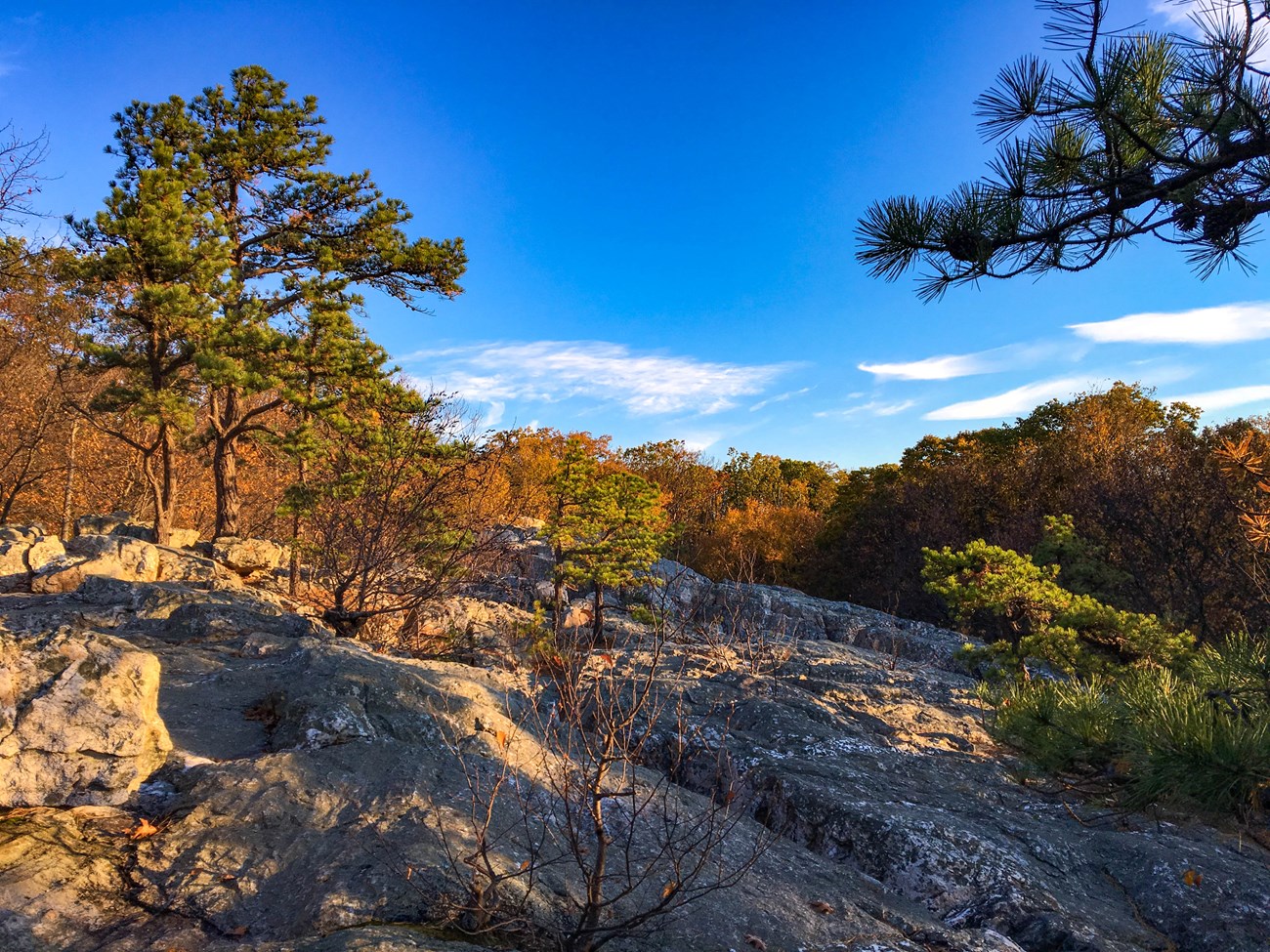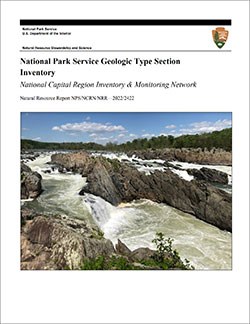
NPS photo by Victoria Stauffenberg.
Geology and Stratigraphy of the National Capital Region I&M Network
The National Capital Region Inventory & Monitoring Network (NCRN) consists of 11 national park units in Maryland, Virginia, Washington, D.C., and West Virginia. These park units include Antietam National Battlefield (ANTI), Catoctin Mountain Park (CATO), Chesapeake and Ohio Canal National Historical Park (CHOH), George Washington Memorial Parkway (GWMP), Harpers Ferry National Historical Park (HAFE), Manassas National Battlefield Park (MANA), Monocacy National Battlefield (MONO), National Capital Parks-East (NACE), Prince William Forest Park (PRWI), Rock Creek Park (ROCR), and Wolf Trap National Park for the Performing Arts (WOTR). The parks that comprise the National Capital Region Network protect a combined 29,468 hectares (72,818 acres) varying in size from 52 hectares (130 acres) in WOTR to 7,936 hectares (19,612 acres) in CHOH.
The geology of the NCRN forms the foundation of a diverse landscape consisting of parks, forest, parkways, trails, monuments, memorials, historic sites, scenic areas, parks for the performing arts, and Civil War-era battlefields. The bedrock underlying the park units of the NCRN dates back to the Mesoproterozoic and records the rich geologic evolution of eastern North America over hundreds of millions of years. Significant geologic events during this time include the opening of the ancient Iapetus Ocean to form the Atlantic Ocean, formation of the Appalachian Mountains, rifting of the supercontinent Pangaea, and subsequent erosion and modification by surface processes to form the modern landscape. See also, Geologic Time Scale - Geology (U.S. National Park Service).
The parklands of the NCRN occur in all of the major physiographic provinces of the central Appalachian region except the Appalachian Plateaus Province. The NCRN parks occur in the following provinces (from east to west): 1) Coastal Plain; 2) Piedmont; 3) Blue Ridge; and 4) Valley and Ridge. The Coastal Plain Province has the lowest topographic relief of these provinces and consists of undeformed, unconsolidated sedimentary rocks and deposits that are separated from deformed, metamorphic rocks of the Piedmont along a transitional boundary known as the “Fall Line”. The Blue Ridge Province is characterized by a highland composed of crystalline, quartz-rich and erosion-resistant metamorphic rocks. The Valley and Ridge and Piedmont Provinces are characterized by low, rolling hills punctuated by a steep gorge along the Potomac River (Southworth and Denenny 2006). The varied geologic history created a wide variety of rocky types and exposures throughout the NCRN that geologists have used as the basis of geologic maps for more than 200 years. Many of the rocks also contain fossils as summarized by Kenworthy and Santucci (2004).
A Brief Geologic History
A few examples of events and Network resources in each geologic time period are highlighted below, from youngest to oldest.
The Cenozoic (rocks and deposits <66 million years old) is represented within every park unit of the NCRN and includes a limited number of formally named geologic units such as the Paleocene Brightseat Formation in GWMP and NACE and Paleocene Aquia Formation, Eocene Marlboro Clay and Nanjemoy Formation, and Miocene Calvert Formation in NACE. Surficial deposits are widespread and include Neogene–Pleistocene terrace deposits (GWMP, NACE, PRWI, ROCR), Quaternary-age fluvial and estuarine deposits (NACE, PRWI), terrace deposits (ANTI, CATO, CHOH, MANA, MONO, PRWI), alluvium (ANTI, CATO, CHOH, HAFE, MANA, MONO, NACE, PRWI, ROCR, WOTR), and colluvium (CHOH, HAFE, MONO, ROCR, WOTR).
Rocks of the Mesozoic Era (between 252 million and 66 million years old) are restricted to a small number of units found within roughly half of the parks of the NCRN. The Triassic Period is represented by the Manassas Sandstone and Bull Run Formation (Balls Bluff Siltstone Member) in CHOH. Rocks of the Bull Run Formation also occur in MANA, in addition to several unnamed Triassic-age diabase dikes, sills, and thermally metamorphosed rocks. Jurassic-age diabase dikes occur in the region of Harpers Ferry in both CHOH and HAFE. Rocks of the Cretaceous Potomac Formation are distributed amongst GWMP, NACE, PRWI, and ROCR. The Severn Formation is also mapped in NACE.
Paleozoic bedrock is mapped in 10 of the 11 park units of the NCRN and represent a diverse assemblage of Cambrian through Mississippian-age units (between 541 million and 323 million years old). Rocks of the Cambrian Chilhowee Group (Loudoun, Weverton, Harpers, and Antietam Formations) are widely distributed amongst CATO, CHOH, and HAFE. Other Cambrian-age strata that are mapped in multiple park units include the Araby Formation (CHOH, MONO), Conococheague Formation (ANTI, CHOH), Elbrook Limestone (ANTI, CHOH), Frederick Formation (CHOH, MONO), Laurel Formation (ROCR), Sykesville Formation (CHOH, GWMP, 13 ROCR), Tomstown Formation (ANTI, CHOH, HAFE), and Waynesboro Formation (ANTI, CHOH, HAFE).
Widely mapped strata of the Ordovician Period include metamorphic and meta-igneous rocks of the Georgetown Intrusive Suite and Dalecarlia Intrusive Suite in CHOH, GWMP, and ROCR. An extensive sequence of Ordovician units underlies CHOH, including the Stonehenge Limestone, Rockdale Run Formation, Pinesburg Station Dolomite, Row Park Limestone, New Market Limestone, Chambersburg Limestone, and Martinsburg Formation. In addition to the igneous units mentioned above, the Ordovician Bear Island Granodiorite and Clarendon Granite underlie GWMP. In PRWI the Ordovician is represented by the Lake Jackson pluton, Quantico Formation, Lunga Reservoir Formation, and Chopawamsic Formation. Unnamed plutonic rocks of Ordovician age are mapped in southeastern WOTR.
Rocks of the Silurian Period include felsic igneous rocks in PRWI as well as units underlying the northern portion of CHOH that include the Tuscarora Formation, Rose Hill Formation, Keefer Sandstone, McKenzie Formation, Bloomsburg Formation, Wills Creek Formation, and Tonoloway Limestone. Some of the youngest Paleozoic strata in the NCRN are found in northern CHOH and consist of the Silurian–Devonian Keyser Limestone and Devonian Helderberg Formation, Oriskany Formation, Needmore Formation, Marcellus Shale, Mahantango Formation, Scherr Formation, Brallier Formation, Foreknobs Formation, Hampshire Formation, and lower Rockwell Formation.
Precambrian-age rocks (>541 million years old) underlie seven of the 11 park units of the NCRN, with some of the oldest bedrock consisting of Mesoproterozoic-age metamorphic and meta-igneous rocks in CHOH and HAFE. Neoproterozoic-age rocks of the Catoctin Formation are mapped in CATO, CHOH, and HAFE. The Neoproterozoic Swift Run Formation is complexly interlayered with basalts of the Catoctin Formation in HAFE (Badger 1999; Tollo et al. 2004). Diabase dikes of Neoproterozoic age are found in both CHOH and HAFE. Metamorphic and meta-igneous rocks of the Neoproterozoic–Cambrian Mather Gorge Formation form the bedrock of CHOH, GWMP, and WOTR, and similarly aged strata of the Ijamsville Phyllite are found in CHOH and MONO. Unnamed Neoproterozoic–Cambrian metamorphic rocks are mapped in GWMP and ROCR.
Geology & Soils—National Capital Region Network Parks
Type Sections—National Capital Region Network

The geologic history above is excerpted from a report titled, "National Park Service geologic type section inventory: National Capital Region Inventory & Monitoring Network". Type sections are essential reference locations for the geoscientists who study geologic history and paleontology. A summary of the type sections in each park can be found at the links below.
-
Antietam National Battlefield, Maryland (no designated stratotypes identified)
-
Catoctin Mountain Park, Maryland (no designated stratotypes identified)
-
Chesapeake and Ohio Canal National Historical Park, Washington D.C., Maryland, and West Virginia (contains 14 identified stratotypes)
-
George Washington Memorial Parkway, Washington D.C., Maryland, and West Virginia (contains one identified stratotype)
-
Harpers Ferry National Historical Park, West Virginia, Virginia, and Maryland (contains four identified stratotypes)
-
Manassas National Battlefield Park, Virginia (contains two identified stratotypes)
-
Monocacy National Battlefield, Maryland (contains one identified stratotype)
-
National Capital Parks-East, District of Columbia (contains one designated stratotype)
-
Prince William Forest Park, Virginia (contains two identified stratotypes)
-
Rock Creek Park, District of Columbia (no designated stratotypes identified)
-
Wolf Trap National Park for the Performing Arts, Virginia (no designated stratotypes identified)
The full Network report is available in digital format from:
Please cite this publication as:
-
Henderson TC, Santucci VL, Connors T, Tweet JS. 2022. National Park Service geologic type section inventory: National Capital Region Inventory & Monitoring Network. Natural Resource Report. NPS/NCRN/NRR—2022/2422. National Park Service. Fort Collins, Colorado.
NPS Stratotype Inventory
Fossil Resources—National Capital Region Network

Between 2002 and 2011, network-based paleontological resource inventories were completed for all the 32 I&M networks, and six of the earliest were completely updated between 2012 and 2016. The report linked below summarizes the paleontological resources of all park units in the National Capital Region Inventory & Monitoring Network (NCRN). The report provides geologic background and paleontological resource data for each park to support management operations, planning, and science-based decision making as required by NPS management policies and the Paleontological Resources Preservation Act (2009).
The full report is available in digital format from
Please cite this publication as:
-
Kenworthy, J.P. and V. L. Santucci. 2004. Paleontological Resource Inventory and Monitoring, National Capital Region. National Park Service TIC# D-289.
Geodiversity Atlas pages—by Inventory & Monitoring Network
Arctic Network Index
Central Alaska Network Index
Chihuahuan Desert Network Index
Cumberland Piedmont Network Index
Eastern Rivers and Mountains Network Index
Great Lakes Network Index
Greater Yellowstone Network Index
Gulf Coast Network Index
Heartland Network Index
Klamath Network Index
Mediterranean Coast Network Index
Mid-Atlantic Network Index
Mojave Desert Network Index
National Capital Network Index
North Coast and Cascades Network Index
Northeast Coastal and Barrier Network Index
Northeast Temperate Network Index
Northern Colorado Plateau Network Index
Northern Great Plains Network Index
Pacific Islands Network Index
Rocky Mountain Network Index
San Francisco Bay Area Network Index
Sierra Nevada Network Index
Sonoran Desert Network Index
South Florida/Caribbean Network Index
Southeast Alaska Network Index
Southeast Coast Network Index
Southern Colorado Plateau Network Index
Southern Plains Network Index
Southwest Alaska Network Index
Upper Columbia Basin Network Index
Geodiversity Atlas pages—by State, U.S. Commonwealth, and Territories
Alabama | Alaska | Arizona | Arkansas | California | Colorado | Connecticut | District of Columbia | Delaware | Florida | Georgia | Hawaii | Idaho | Illinois | Indiana | Iowa | Kansas | Kentucky | Louisiana | Maine | Maryland | Massachusetts | Michigan | Minnesota | Mississippi | Missouri | Montana | Nebraska | Nevada | New Hampshire | New Jersey | New Mexico | New York | North Carolina | North Dakota | Ohio | Oklahoma | Oregon | Pennsylvania | Rhode Island | South Carolina | South Dakota | Tennessee | Texas | Utah | Vermont | Virginia | Washington | West Virginia | Wisconsin | Wyoming
U.S. Commonwealth and Territories
Region 2: South Atlantic-Gulf (Includes Puerto Rico and the U.S. Virgin Islands)
Region 3: Great Lakes
Region 4: Mississippi Basin
Region 5: Missouri Basin
Region 6: Arkansas-Rio Grande-Texas-Gulf
Region 7: Upper Colorado Basin
Region 8: Lower Colorado Basin
Region 9: Columbia-Pacific Northwest
Region 10: California-Great Basin
Region 11: Alaska
Region 12: Pacific Islands (American Samoa, Hawaii. Guam, Commonwealth of the Northern Mariana Islands)
Last updated: February 21, 2025
